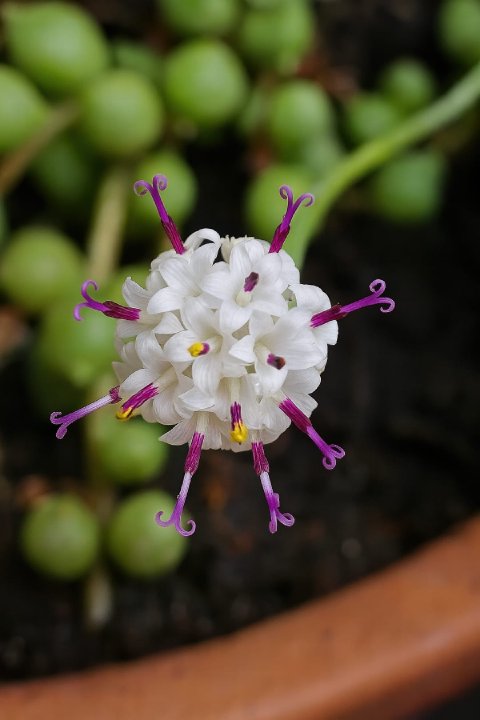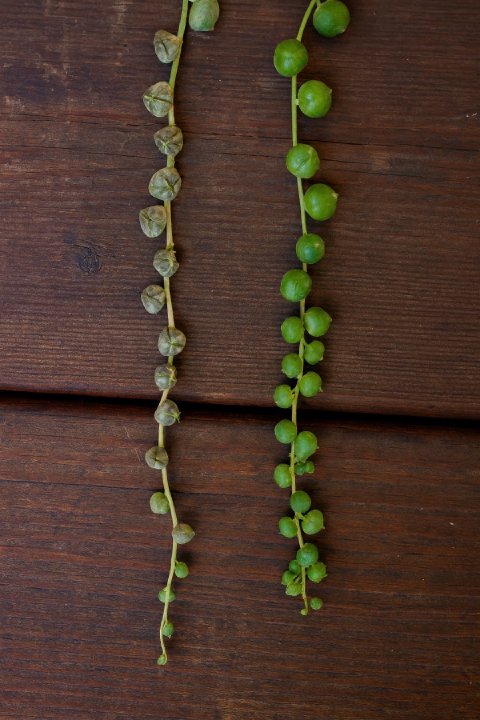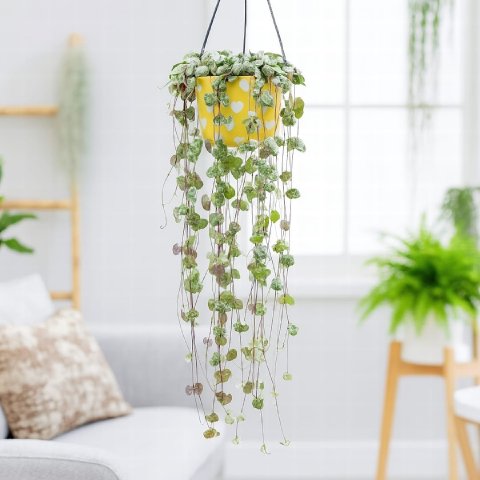
String of Pearls
Curio rowleyanus
String of Beads, Rosary Plant
String of Pearls is a unique and captivating succulent, beloved for its long, trailing stems adorned with bead-like leaves. Learn how to master its care, from watering to propagation.
📝 String of Pearls Care Notes
🌿 Care Instructions
⚠️ Common Pests
📊 Growth Information
🪴 In This Guide 🪴
☀️ Light Requirements for String of Pearls
Ideal Light Conditions
Bright light is the key to a healthy, happy String of Pearls. It thrives with a combination of bright, indirect light for most of the day, with a few hours of gentle, direct morning sun. An east-facing window is often the perfect location. A south or west-facing window can also work, as long as the plant is protected from the harshest midday and afternoon sun, which can scorch the delicate pearls.
Crucially, the top of the plant (the soil level) needs to be well-lit. If the top is in shadow (which often happens in hanging baskets), the strands can thin out at the base and eventually die off, leaving you with long but bare strings.

Best & Worst Light Conditions
- Best Light Conditions:
- In an east-facing window.
- On a high shelf or in a hanging basket a foot or two away from a south or west-facing window.
- A spot where the top of the pot receives several hours of direct morning sun.
- Avoid:
- Intense, direct afternoon sun, which will cause sunburn.
- Low-light conditions, which will lead to sparse growth, weak stems, and an increased risk of rot.
💧 Watering Needs for String of Pearls
The Golden Rule: When in Doubt, Don't
Overwatering is the fastest way to kill a String of Pearls. As a succulent, it is extremely drought-tolerant and stores water in its round leaves. It must be allowed to dry out completely between waterings.
The best method is “soak and dry.” Water the plant thoroughly until water runs out the drainage holes, then do not water it again until the soil is 100% dry all the way through the pot.
A great tip is to watch the pearls themselves. When the plant is thirsty, the small, translucent “windows” on the pearls will start to close, and the beads will look slightly deflated or pointed instead of perfectly round. This is the best time to water.
How to Water
Bottom watering is an excellent technique for this plant. It allows the shallow roots to absorb what they need without soaking the top of the plant, which can promote rot.
- Place the pot in a sink or basin with a few inches of water.
- Let it sit for 10-15 minutes to absorb water from the bottom up.
- Once the top of the soil is moist, remove it from the basin and let it drain completely.
Signs of Improper Watering
- Overwatering: The pearls will look mushy, yellow, and may burst. The soil will be damp, and the base of the stems will rot. This is a sign of root rot.
- Underwatering: The pearls will look shriveled, wrinkled, and slightly flattened or pointed. The soil will be bone dry.
🌱 Soil Requirements for String of Pearls
Drainage is Everything
Like all succulents, String of Pearls requires a soil mix with excellent drainage. A dense, water-retentive potting soil will hold moisture for too long and lead directly to root rot.
The best choice is a commercially available cactus or succulent potting mix. These are specially formulated to be gritty and fast-draining.
DIY Succulent Mix Recipe
If you’d like to make your own superior mix, a simple and effective recipe is:
- 2 parts standard potting soil
- 1 part perlite or pumice
- 1 part coarse sand
This mixture ensures that water flows through quickly and the roots get the aeration they need.
🌡️ Temperature Requirements for String of Pearls
Ideal Temperature Range
String of Pearls is comfortable in average household temperatures. It is not frost-tolerant and should be protected from cold drafts.
- Ideal Range: 65-80°F (18-27°C).
- Winter Care: It can tolerate cooler temperatures in winter (down to 50°F / 10°C), which can help encourage it to bloom.
Keep it away from open windows in the winter and blasting heaters.
💦 Humidity Needs for String of Pearls
Dry Air is Best
This is one plant that does not want high humidity. Originating from dry regions of Africa, String of Pearls prefers arid conditions. Average to low household humidity is perfect.
There is no need for misting, pebble trays, or humidifiers. In fact, consistently moist air can promote stem rot and fungal issues. Ensure good air circulation around the plant.
🌿 Fertilizing String of Pearls
A Light Feeder
This succulent does not require much fertilizer. Too much can lead to weak, leggy growth.
- Growing Season (Spring and Summer): You can feed it once or twice during the entire season.
- Dormant Season (Fall and Winter): Do not fertilize at all.
Use a balanced houseplant fertilizer or a cactus/succulent fertilizer diluted to half or a quarter of the recommended strength.
📃 Types of String of Pearls
Popular Varieties
While the classic green String of Pearls is the most common, there is one highly sought-after cultivar:
- ‘Variegata’ - Variegated String of Pearls: This stunning version features pearls with beautiful cream, yellow, or even pink splashes and stripes. The care is identical to the standard green form, but the variegated sections are more sensitive to direct sun and can burn easily. It often requires even brighter indirect light to maintain its colors.
There is also a “String of Tears” plant (Curio herreanus) which looks very similar but has teardrop-shaped leaves instead of perfectly round ones.
🌸 Does String of Pearls Bloom?

A Spicy Surprise
Yes, it does! A happy and mature String of Pearls can produce small, white, composite flowers that look like little brushes. They have a lovely, faint scent that is often compared to cinnamon or cloves.
Blooming is most often triggered by a cool, dry period in the winter followed by the start of the growing season. While it’s a wonderful sign of a healthy plant, don’t worry if yours never blooms indoors; it’s grown primarily for its incredible foliage.
🪴 Potting and Repotting String of Pearls
Shallow Roots, Shallow Pot
String of Pearls has a very shallow root system and prefers to be slightly crowded in its pot. This helps the soil dry out faster, reducing the risk of rot.
- Pot Choice: A shallow, wide pot (often called a “bulb pan”) is a better choice than a deep one. Always use a pot with drainage holes. Terracotta is an excellent material choice as it wicks moisture away from the soil.
- Frequency: Repot only every 2-3 years, or when the plant has completely filled the pot.
- How to Repot: Repot into a container that is only 1 inch wider than the previous one. Be very gentle with the delicate strands. After repotting, wait a few days before watering to allow any broken roots to heal.
✂️ Pruning String of Pearls
A Haircut for Health
Pruning is great for a String of Pearls. It encourages the plant to branch out, creating a fuller look at the base, and it keeps the strands from getting too long and tangled.
- Why Prune: To promote fullness, control length, and remove any dead or dying stems.
- How to Prune: Using clean, sharp scissors, simply snip the strands to your desired length.
- Don’t Waste Cuttings! Every piece you prune can be easily propagated to create new plants or make the current plant fuller.
🖼️ Display Ideas for String of Pearls

Showcasing the Cascade
The entire appeal of this plant is its trailing nature. The best way to display it is to let it hang.
- Hanging Baskets: The classic choice. Hang it near a bright window and let the strands create a living curtain of beads.
- High on a Shelf: Placing it on the edge of a tall bookshelf, cabinet, or mantlepiece allows the strands to cascade down dramatically.
- Face Planters: A whimsical trend is to use a “head” or “face” planter and let the strings of pearls act as the ‘hair.’
- Mixed Succulent Arrangement: It can be used as the “spiller” element in a container with other succulents, trailing beautifully over the pot’s edge.
🐛 Common Pests
Pests to Watch For
String of Pearls is not particularly pest-prone, but it can occasionally attract common houseplant pests.
- Mealybugs - These white, cottony pests like to hide in the dense growth at the base of the plant.
- Aphids - Aphids are often attracted to the tender new growth and flower buds. If you spot pests, isolate the plant and treat them by dabbing with a cotton swab soaked in rubbing alcohol or by using an insecticidal soap.
🩺 Common Problems

Troubleshooting Your String of Pearls
Most issues with this plant are related to incorrect watering or lighting.
Root Rot - This is the #1 killer of String of Pearls. Caused by overwatering or poor drainage, its signs include mushyv stems at the base and yellowing leaves (pearls). The plant may look wilted even when the soil is wet because the roots are no longer functional.
Wilting & Drooping - Shriveled, deflated, or wrinkled pearls are the most common sign of a thirsty plant. This indicates it is time to water. However, these same symptoms can also be a sign of advanced root rot, as the dead roots can no longer absorb water for the plant. Always check the soil moisture before watering.
Leggy Growth - If your plant has long, bare stems near the soil with pearls spaced far apart, it is not getting enough light. This ‘stretching’ is the plant reaching for a brighter light source. It’s especially common for the top of the plant to be too shaded.
Sunburn & Leaf Scorch - While they need bright light, intense, direct sun can be too much. It can cause the delicate pearls to get brown or greyish scorch marks on their surface.
🌿 How to Propagate String of Pearls

Creating New Plants
String of Pearls is one of the easiest houseplants to propagate. Every cutting is an opportunity for a new plant! The best method is using soil. For fundamentals and best practices, see our Succulent Propagation Guide.Propagation in Soil (Recommended)
This method is highly successful and is also a great way to make the parent plant look fuller.
- Take Cuttings: Using clean scissors, snip several healthy strands, each about 4-5 inches long.
- Prepare the Pot: Fill a shallow pot with fast-draining succulent soil.
- Lay on Soil: Gently remove the pearls from one end (about an inch) of each cutting. Lay the cuttings flat on top of the soil, coiling them around. You can use a small hairpin or a piece of a paperclip to gently secure the bare part of the stem against the soil.
- Wait for Roots: Place the pot in bright, indirect light. Keep the soil lightly moist (misting every few days is effective) to encourage rooting. Do not saturate the soil.
- New Growth: In a few weeks, roots will grow from the nodes along the stem. Once rooted, you can care for it as a mature plant.
Propagation in Water
This method is also possible and fun to watch.
- Take Cuttings: Prepare cuttings as described above, removing the bottom inch of pearls.
- Place in Water: Submerge the bare stem end of the cuttings in a jar of water. Ensure no pearls are sitting in the water.
- Wait for Roots: Place the jar in a bright spot and change the water every few days. Roots should appear in a few weeks.
- Transplant: Once the roots are about an inch long, you can gently transplant them into soil. The transition can be a bit of a shock, so keep the soil lightly moist for the first week.
🌟 PRO Tips for a Thriving String of Pearls
✅ Light on Top: Remember that the top of the pot needs light as much as the strands do. A bald top is a light-starved top.
✅ Bottom Water: Master the technique of bottom watering to prevent the delicate crown of the plant from staying too wet.
✅ Shallow Pot Power: Use a shallow terracotta pot. It helps the soil dry out evenly and quickly, which is exactly what the shallow roots of this plant want.
✅ The Pearl Test: Don’t just water on a schedule. Look at the pearls! When they go from perfectly round to slightly deflated and pointed, it’s the perfect time to water.
✅ Propagate for Fullness: Don’t be afraid to give your plant a haircut. Laying the cuttings back onto the soil is the #1 secret to achieving that lush, full look everyone wants.
❓ Frequently Asked Questions
Why is my String of Pearls shriveling?
Shriveled pearls are a sign of a water issue, but it can be confusing. It’s most often caused by underwatering-the plant is thirsty. However, it can also be a symptom of root rot from OVERwatering. If the roots have rotted, they can no longer absorb water, so the plant shrivels. Check the soil: if it’s bone dry, you need to water. If it’s damp, you must check the roots for rot.Is String of Pearls toxic to cats and dogs?
Yes, String of Pearls is mildly toxic to cats, dogs, and humans if ingested. It can cause gastrointestinal upset like vomiting and diarrhea, as well as skin irritation. Keep it out of reach of pets and children.How do I make my String of Pearls fuller on top?
To get a full, lush base, ensure the top of the plant gets direct, bright light. You can also take cuttings from the longer strands and lay them directly on top of the soil. The cuttings will root along the stem, creating new growth points and a fuller appearance.What do the little slits on the pearls mean?
Those translucent lines are called ’epidermal windows.’ In its native habitat, this allows sunlight to enter the leaf’s interior to maximize photosynthesis while minimizing water loss from the leaf surface. They are a fascinating evolutionary adaptation!ℹ️ String of Pearls Info
Care and Maintenance
🪴 Soil Type and pH: Cactus/Succulent Mix
💧 Humidity and Misting: Low humidity preferred; dislikes moist air.
✂️ Pruning: Trim strands to encourage fullness at the top and control length.
🧼 Cleaning: Generally not needed; a gentle shake can dislodge dust.
🌱 Repotting: Every 2-3 years; prefers to be slightly root-bound in shallow pots.
🔄 Repotting Frequency: Every 2-3 years
❄️ Seasonal Changes in Care: Reduce watering significantly in fall and winter.
Growing Characteristics
💥 Growth Speed: Moderate
🔄 Life Cycle: Perennial
💥 Bloom Time: Typically in fall or winter, though infrequent indoors.
🌡️ Hardiness Zones: 9-12
🗺️ Native Area: Southwest Africa
🚘 Hibernation: Yes (winter dormancy)
Propagation and Health
📍 Suitable Locations: Hanging baskets, high shelves, mixed succulent containers.
🪴 Propagation Methods: Very easy from stem cuttings laid on soil or rooted in water.
🐛 Common Pests: aphids, and mealybugs
🦠 Possible Diseases: Root rot is the primary disease concern.
Plant Details
🌿 Plant Type: Trailing Succulent
🍃 Foliage Type: Evergreen
🎨 Color of Leaves: Green, Variegated (cream/pink)
🌸 Flower Color: White, small, brush-like
🌼 Blooming: Infrequently
🍽️ Edibility: Not edible; mildly toxic.
📏 Mature Size: 3-5 inches (base)
Additional Info
🌻 General Benefits: Unique appearance, excellent trailing plant.
💊 Medical Properties: None known. Toxic.
🧿 Feng Shui: Symbolizes a string of tears, but also purity and wealth in some interpretations.
⭐ Zodiac Sign Compatibility: Cancer
🌈 Symbolism or Folklore: Patience, persistence, memories
📝 Interesting Facts: Each ‘pearl’ is a modified leaf with a small, translucent slit (epidermal window) that allows light to penetrate the interior for photosynthesis, an adaptation to its dry native environment.
Buying and Usage
🛒 What to Look for When Buying: Look for a plant that is full at the top with plump, firm pearls. Avoid plants with lots of shriveled pearls or bare stems at the base.
🪴 Other Uses: Spiller plant in container arrangements.
Decoration and Styling
🖼️ Display Ideas: Hanging near a bright window, trailing from a bookshelf, or in a pot with a face where the strands look like hair.
🧵 Styling Tips: Its delicate, cascading form pairs well with minimalist or bohemian decor. Use a shallow, wide pot to help the top of the plant stay healthy.
